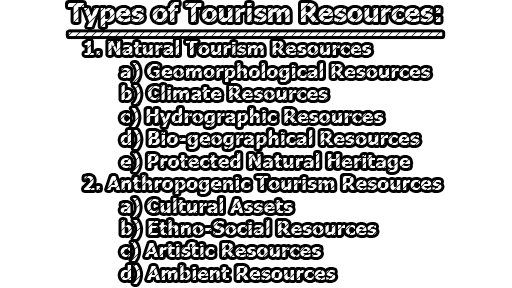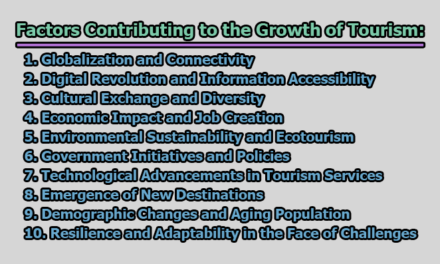Types of Tourism Resources:
Tourism resources are the natural and anthropogenic elements that attract tourists to a destination. These resources are crucial in the tourism industry as they help to create a unique experience for tourists and contribute to the economic growth of a destination. In this article, we will discuss the different types of tourism resources.
1. Natural Tourism Resources: Natural tourism resources are the natural elements that attract tourists to a destination. These resources include geomorphological, climate, hydrographic, biogeographical, and protected natural heritage.
a) Geomorphological Resources: Geomorphological resources refer to the geological formations that attract tourists to a destination. These resources include mountains, caves, valleys, canyons, and beaches. For example, the Grand Canyon in the United States is a geomorphological resource that attracts millions of tourists every year.
Other examples of geomorphological resources include Mount Everest in Nepal, the Great Barrier Reef in Australia, and the Niagara Falls in Canada. These resources offer visitors a chance to witness the unique geological formations of the region.
b) Climate Resources: Climate resources refer to the different types of climates that attract tourists to a destination. These resources include tropical, arid, continental, polar, and Mediterranean climates. For example, tourists visit the Caribbean islands to experience the warm tropical climate and the sandy beaches.
Other examples of climate resources include the deserts of Egypt, the polar regions of Antarctica, and the Mediterranean climate of Southern Europe. These resources offer visitors a chance to experience the unique climate of the region.
c) Hydrographic Resources: Hydrographic resources refer to the water bodies that attract tourists to a destination. These resources include rivers, lakes, waterfalls, and oceans. For example, tourists visit the Amazon River in Brazil to witness the unique biodiversity of the region.
Other examples of hydrographic resources include Lake Baikal in Russia, Victoria Falls in Zimbabwe, and the Great Lakes in the United States. These resources offer visitors a chance to witness the unique water bodies of the region.
d) Bio-geographical Resources: Biogeographical resources refer to the unique flora and fauna that attract tourists to a destination. These resources include national parks, wildlife reserves, and botanical gardens. For example, tourists visit the Serengeti National Park in Tanzania to witness the unique wildlife of the region.
Other examples of biogeographical resources include the Galapagos Islands in Ecuador, the Amazon Rainforest in Brazil, and the Yellowstone National Park in the United States. These resources offer visitors a chance to witness the unique flora and fauna of the region.
e) Protected Natural Heritage: Protected natural heritage refers to the areas that are protected by law for their natural or cultural value. These areas include UNESCO World Heritage Sites, national parks, and wildlife reserves. For example, tourists visit the Taj Mahal in India, a UNESCO World Heritage Site, to witness the unique cultural heritage of the region.
Other examples of protected natural heritage include the Great Barrier Reef Marine Park in Australia, the Yellowstone National Park in the United States, and the Machu Picchu in Peru. These resources offer visitors a chance to witness the unique cultural and natural heritage of the region.
2. Anthropogenic Tourism Resources: Anthropogenic tourism resources are the man-made elements that attract tourists to a destination. These resources include cultural assets, ethno-social resources, artistic resources, and ambient resources.
a) Cultural Assets: Cultural assets refer to the unique cultural features and attractions that attract tourists to a destination. These include museums, historical landmarks, and cultural festivals. For example, tourists visit the Colosseum in Italy to witness the unique cultural heritage of the region.
Other examples of cultural assets include the Acropolis in Greece, the Pyramids in Egypt, and the Angkor Wat in Cambodia. These resources offer visitors a chance to witness the unique cultural heritage of the region.
b) Ethno-Social Resources: Ethno-social resources refer to the cultural and social traditions of a destination that attract tourists. These resources include food, music, dance, and traditional clothing. For example, tourists visit New Orleans in the United States to experience the unique jazz music and cuisine of the region.
Other examples of ethno-social resources include the tango in Argentina, the Maasai tribe in Kenya, and the flamenco in Spain. These resources offer visitors a chance to experience the unique cultural and social traditions of the region.
c) Artistic Resources: Artistic resources refer to the artistic creations and performances that attract tourists to a destination. These resources include architecture, music, dance, theater, and visual arts. For example, tourists visit Paris in France to witness the unique architecture and art of the region.
Other examples of artistic resources include the opera in Italy, the Broadway theater in New York City, and the street art in Berlin. These resources offer visitors a chance to witness the unique artistic creations and performances of the region.
d) Ambient Resources: Ambient resources refer to the environmental and atmospheric features of a destination that attract tourists. These resources include clean air, clean water, and a safe environment. For example, tourists visit New Zealand for its clean and green environment.
Other examples of ambient resources include the natural beauty of Norway, the eco-tourism in Costa Rica, and the sustainable tourism in Bhutan. These resources offer visitors a chance to experience a safe and healthy environment while traveling.
It is apparent that tourism resources are the natural and anthropogenic elements that attract tourists to a destination. These resources are crucial in the tourism industry as they help to create a unique experience for tourists and contribute to the economic growth of a destination. Natural tourism resources include geomorphological, climate, hydrographic, biogeographical, and protected natural heritage, while anthropogenic tourism resources include cultural assets, ethno-social resources, artistic resources, and ambient resources. By understanding and developing these resources, destinations can attract more tourists and boost their economy.
References:
- Buhalis, D. (2000). Marketing the competitive destination of the future. Tourism Management, 21(1), 97-116.
- Jamal, T. B., & Getz, D. (1995). Collaboration theory and community tourism planning. Annals of tourism research, 22(1), 186-204.
- Kim, H. J., & Ritchie, J. R. (2014). Tourism destination development: A review of recent research. Tourism Management Perspectives, 10, 11-23.
- Middleton, V. T. (1994). Marketing in travel and tourism. Routledge.
- Pearce, D. G. (1989). Tourist development. Longman Group.
- Sharpley, R., & Telfer, D. J. (Eds.). (2014). Tourism and development: Concepts and issues (Vol. 1). Channel View Publications.
- (2017). UNWTO tourism highlights, 2017 edition. World Tourism Organization.
- Weaver, D. B. (2006). Sustainable tourism: Theory and practice. Butterworth-Heinemann.
- World Tourism Organization. (2019). Tourism Highlights, 2019 Edition. Madrid, Spain: UNWTO.
- Yuksel, A., Yuksel, F., & Bilim, Y. (2018). Destination branding for sustainable tourism: A case study of Antalya, Turkey. Journal of Destination Marketing & Management, 8, 67-77.

Library Lecturer at Nurul Amin Degree College










